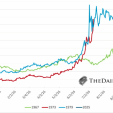The Fed Is Backed Into A Corner
The minutes of the Fed’s last FOMC meeting, released this week, confirm that the Fed believes it must begin to taper back its stimulus soon. At this point, the longer QE continues the greater the risk of asset bubbles forming, the bursting of which would destabilize the economy and make it even more difficult to exit.
Economists and analysts have been concerned from the beginning about how the Fed would be able to reverse the massive QE stimulus, which has been the major driving force of the anemic economic recovery and the powerful bull market in stocks, without also reversing the momentum of both.
Fed Chairman Bernanke has always provided assurances that the Fed would have ways of doing that when the time arrives.
But the Fed’s guidance and actions so far this year have indicated that it does not have a firm exit strategy in place at all. Since its first hints in May that it had begun thinking about tapering, it has looked very much like the Fed was experimenting, throwing out various trial balloons to test the reaction of markets, and then pulling them back in each time when it didn’t like what it saw.
Each of the Fed’s hints about tapering in May, August, and September sent markets tumbling, until the Fed rushed back in each time to say that markets had misunderstood, that it wasn’t going to do it right away.

The minutes of the last FOMC meeting, released this week, convey much the same picture, of a Fed that is anxious to begin tapering but worried about how to go about it.
Much of the meeting seemed to center around not just when tapering should begin, but more so on how to manage it without panicking markets. Participants discussed the wording that could be used in introducing the change, and new promises that could be made in the Fed’s forward guidance, while worrying that "communicating them could present challenges".
Among the thoughts expressed were that "It might be appropriate to offset the effects of reduced QE purchases by undertaking alternative actions to provide accommodation at the same time." Or that it could change its current forward guidance that it will keep interest rates near zero until unemployment falls to 6.5%, to a promise to do so until joblessness reaches an even lower level, which Chairman Bernanke floated in a speech this week.
Clearly the Fed sees it has a problem as it moves toward actual tapering, if just the hints of tapering began to panic markets this summer.
Meanwhile, conditions are not cooperating either.
It had been expected that the unusual easy money policies would create rising inflation, and some inflation would be a positive for the economy. Early on, the Fed set a target of 2% as a limit above which easy money policies would have to be rethought.
However, inflation has inexplicably been declining instead, especially over the last 12 months. The Producer Price Index, measuring inflation at the producer level, declined 0.2% in October, and is up only 0.3% over the last 12 months. The Consumer Price Index, measuring inflation at the consumer level, declined 0.1% in October, and is up only 1.0% year-over-year.
Gold, historically a hedge against rising inflation, topped out at $1,900 an ounce in 2011, and has plunged 35% since; indicating it also believes that inflation is no longer a threat.
Meanwhile, deflationary concerns have also suddenly risen in Europe. It was reported last month that inflation in the euro-zone was running at an annualized rate of just 0.7% in October, well below the ECB’s target of 2%. The ECB reacted immediately by cutting its key interest rate from 0.5% to 0.25%, a record low. Economists worry that the declining prices for goods in the euro-zone are hurting business profits, weighing on hiring and business profits, and raising odds that the anemic euro-zone recovery could slip back into recession.
ECB President Mario Draghi said the ECB even discussed the possibility of setting interest rates at a negative rate (less than 0%) at its monthly meeting, an indication of the concern about deflation, and that he is under pressure to introduce a program of quantitative easing similar to that of QE in the U.S.
The emergence of a deflationary threat has to be an additional concern to the Fed as it considers when and how to exit its QE program.
Hopefully the Fed will find enough excuses in the economic and inflation reports, or on concerns about how Congress will handle its next chance to reach agreement on a budget and the debt ceiling before the new deadline of January and February, to keep the stimulus in place and markets positive through year-end and until April or May.
But evidence is piling up that 2014 is going to be an interesting year to say the least, probably not at all like 2013.
********
Sy is president of StreetSmartReport.com and editor of the free market blog Street Smart Post. Follow him on twitter @streetsmartpost. He was the Timer Digest #1 Gold Timer for 2012 (Gold Timer of the Year), as well as the #2 Long-Term Stock Market Timer.

















